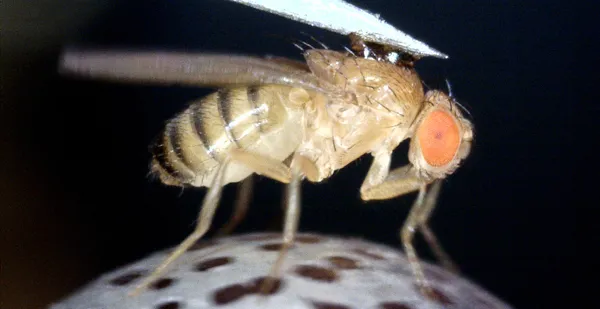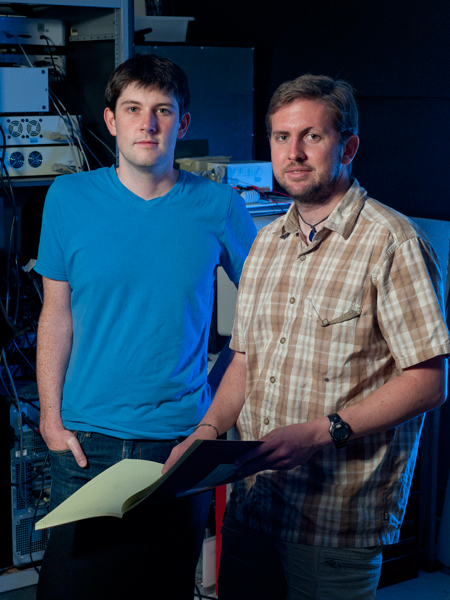
Stanford Report, September 12th, 2011 - by Max McClure
Flies like watching computer screens as much as the next animal. Set them on a trackball in front of a monitor, and they'll follow the action – if the images in front of them move in one direction, the flies will try to move the same way.
That's because flies – like humans, monkeys, birds and a host of other animals – can perceive what researchers call "phi motion." If a bright point appears at one position, and then reappears at a position shifted to the right, we tend to see a single object moving left to right. It's a basic effect, and one that underlies the apparently fluid motions we see in movies and animations.
A fruit fly sitting on a tiny trackball helps an interdisciplinary group of scientists understand how our brains perceive motion.
But all of these animals also perceive an odd "reverse-phi" illusion. If the second point we see is the opposite of the first – with a dark point becoming light, for example – we see motion away from the second point, rather than toward it.
For years, researchers thought this second illusion was an artifact of "normal" motion vision, and was not involved in real motion perception. The effect, it was argued, simply wouldn't appear outside a laboratory setting.
Now, a group of Stanford biologists, physicists and computational scientists are turning this view on its head. In papers published last month in the journals Neuron and Proceedings of the National Academy of Sciences, researchers demonstrate that this and other illusions appear integral to how fly brains process motion. And in doing so, the scientists may have come up with a new understanding of how we see movement.
"Motion vision is one of the more basic things that our brains can do," explained Thomas Clandinin, associate professor of neurobiology and a senior author of the two studies. "Nearly everything that has an eye uses it."
But judging motion can be more difficult than it sounds. The problem is essentially one of correlation – the brain needs to associate changes in one part of the visual field with changes elsewhere.
How this is accomplished isn't fully understood, even in simple animals like fruit flies. But we do know that a fly brain's first step should be to distinguish between different types of contrast changes.
In fact, fly photoreceptors appear to send visual motion information to the brain down two separate neural pathways. One pathway responds to dark edges moving onto bright backgrounds, while the other reacts only to the opposite: bright edges moving onto dark backgrounds.
Researchers initially proposed this was a case of "on" and "off" pathways – the neurons in one pathway should respond to darkening, while neurons in the other pathway should respond to brightening. But Damon Clark, a postdoctoral scholar in neurobiology and primary author of the Neuron paper, found an alternative explanation.
"That model is a perfectly good way to be selective for dark and bright edges," explained Clark, "but there's another way that appears to actually be encoded in the circuits."
Instead, what seem to distinguish the pathways are their responses to the reverse-phi illusion. One pathway is responsible for recognizing dark-to-bright changes, while the other responds to bright-to-dark shifts.
With computer modeling, the researchers showed that this kind of selectivity was enough to explain the flies' ability to distinguish between edge types. Clark had noticed that reverse-phi motion wasn't just a special type of motion – it takes place every time an edge moves across a background.
When a dark edge is moving to the right, a fly brain could look at it in the "phi motion" way: dark points on the left are followed by the appearance of dark points on the right. But by looking first at the bright background, the fly brain could also see a signal in the opposite direction – the bright points on the right are followed by dark points on the left.
What was thought to be a laboratory artifact was, in fact, happening in the real world. And, in context, this seemingly bizarre reversal of direction was perfectly reasonable.
As Clark put it, "If reverse phi, as unintuitive as it appears, is actually useful to extract motion from visual scenes, then what other structures could be used to help perceive motion?"
James Fitzgerald, a graduate student in physics and first author on the PNAS paper, crafted an elegant model to answer the question. Taking a theoretical approach, he agreed that there was a disconnect between what labs were looking for and what the real world was like – but thought it went beyond the reverse-phi illusion.
Typically, labs test visual motion detection with images that contain statistically equivalent dark and bright stimuli – meaning that there is no way of distinguishing foreground shades from background shades. The real world works differently.
"Natural statistics have strong asymmetries between dark and light," explained Fitzgerald. Brightness and darkness are defined in relation to the rest of the visual field. In natural environments, dark regions are only slightly dimmer than average, but occupy a great deal of space. Light regions take up little space, but are proportionally much brighter than average.
This built-in asymmetry allows the animal's expectations to play a role in perception. A fly brain can better estimate motion by giving common, darker shades background status while focusing on changes in more unusual contrasts.
By taking expectations into account, the researchers have devised a more powerful model for motion perception in both flies and humans. Traditional theories assume that, when estimating motion, the brain only compares the changes of two points in space. Fitzgerald's model suggests the brain correlates changes at three or more points.
"Illusions in general may just be natural signatures of motion taken out of context," said Fitzgerald.
This offers an explanation for a host of other questions about visual perception, including a long-debated class of motion illusions called "non-Fourier motion." When humans look at these displays, they perceive movement – but traditional, two-point models of motion perception see them as motionless.
"This model is completely general," said Clandinin. "It provides a framework to think about not just the reverse-phi illusion, but every motion illusion that's been observed."
Clark and Fitzgerald are now in collaboration, testing the model's predictions for fly behavior. Their research is supported by a National Science Foundation Integrative Graduate Education and Research Traineeship from the Stanford Center for Mind, Brain and Computation. Mark Schnitzer, associate professor of biology and of applied physics, was also a senior author on both studies.


